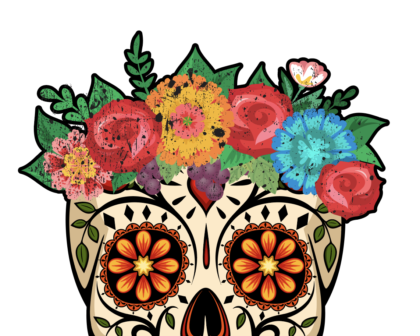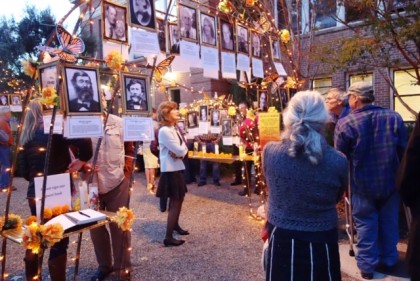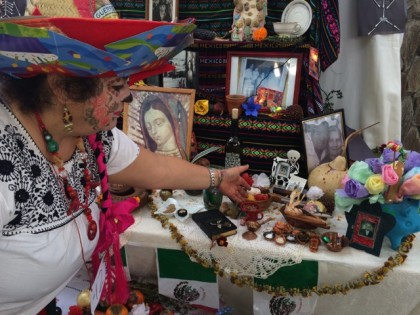Halloween and Días de Los Muertos

By Anna Pier | From The Sun Archives
Halloween is a celebration that has gained huge traction in the last 50 years, for many moving to the top of the holidays hit parade. When I was little, only children participated, dressing in simple costumes and “trick or treating” neighbors you knew, and joining the parade down the town’s main drag. Today the holiday has expanded beyond October 31. People extravagantly decorate their houses weeks ahead with a gusto that was once reserved for Christmas, turning them into ghoulish showplaces. Now adults participate in dressing up too, renting, scavenging in second-hand stores, and putting together complicated costumes, not only to wear to elaborate parties but to work as well. Pumpkin farms abound. It has become a beloved holiday. And the children, well, it’s estimated that there are 38 million trick or treaters each year.
But if you ask almost anybody participating in the revels, it’s unlikely they will be able to tell you what is being celebrated. The name tells all, but few know that “hallow” from the Old English “holy” refers to someone saintly. In fact, the holiday is often mispronounced as “holloween”; clearly there is a disconnect to the reason for the season. October 31 is the eve of All Saints, once known as All Hallows Day. So “Hallows Eve, or Even, and finally E’en with the “v” dropped out became Halloween. It is integrally connected to the Christian feasts of All Saints and All Souls, known in Spanish-speaking countries as Días de los muertos (Days of the Dead).
What then is the origin of our Halloween tradition of dressing up? There is a mistaken perception that the celebration of Halloween originated in the U.S. Its roots lie in the ancient Celtic festival known as Samhain, which celebrated the end of harvest and the beginning of the new year. People lit bonfires and wore scary costumes to ward off roaming ghosts of spirits returning to earth. Irish immigrants brought these traditions to the US in the mid-1800s, including the carving of pumpkins in the image of Jack the trickster, thought to be able to trick the devil.
Porfirio Diaz, dictator of Mexico for 33 years, famously quipped about his country: “Poor Mexico. So far from God, so close to the United States.” And unquestionably, the United States has exerted an inordinate influence on Mexico. But somehow in regard to this spiritual and cultural observance, Mexico has prevailed. The observance of traditional and religious celebrations known as Días de los muertos, Days of the dead, is becoming a tradition in this country.
In our Valley, and many other places in California and the southwest where immigrants from Mexico have put down roots, those raised on Halloween, are opening our hearts and minds to this rich celebration honoring the dead.

How do Mexicans who remember their dead loved ones on November 1 and 2, feel about Halloween? I once saw a bumper sticker that said – “No me gusta el pinche Jalouín” (“I don’t like f—- /damn Halloween” – as phonetically transcribed into Spanish.) If Halloween is observed, it is as Noche de brujas – Witches Night. It is largely incomprehensible to those who grew up in Mexico respecting their dead with the traditional spiritual celebrations. A friend who lives in Valladolid tells me that the mayor there “is working to side-step the intrusion of U.S.-style Halloween by more deeply respecting the intact indigenous customs of Yucatan.”
Several Sonoma Valley mothers from Mexico who are raising their families here in the Valley said their children do get dressed up and go trick or treating, but in their homes there are no Halloween decorations or celebrations. And no one I spoke with understood the integral relationship of the celebrations.
Yet both are blends of Christian and non-Christian customs. As with Halloween, Días de los muertos has deep historical roots in a pre-Christian world. The culture of indigenous people of Meso-america – especially the Aztecs, Mayans and Toltecas, native to Mexico for more than 3,000 years, welcomed and honored the spirits of their departed loved ones at this time of year. When the Spaniards conquered the country, they were not successful in eradicating the deep spiritual beliefs of the people. So the indigenous celebration merged with the Christian observance.
The most familiar symbol of Dia de los Muertos are the calacas and calaveras (skeletons and skulls), which appear everywhere during the holiday: as sugar skulls, parade masks, as dolls. Calacas and calaveras are almost always portrayed as enjoying life. Sonoma resident Lourdes (Lulú) Baltazar spoke of the ‘alegría’ that marks the celebration, the joy in welcoming the spirits of dear departed ones, who have left the pain and travail of earthly life. She explained, “That is the reason we decorate with brightly colored papel picado on the altars. It is a joyful occasion.”
Baltazar described the traditional way to assemble an altar that she learned from her mother who came from Veracruz near Oaxaca, and her father from our sister city Pátzcuaro. Both areas are centers of Muertos celebrations in México. The four elements are represented; the stars and sun to guide the spirits; xempasúchil flowers (marigolds), whose bright beauty marks a path to the home; the favorite foods of the departed, as well as pan de muertos, a traditional bread; and of course a photo of the departed.
 Another Sonoman, Carmen García, who came here from Jalaisco 14 years ago, said that as a child she went with her family to the cemetery to decorate the graves of their departed family members, and hold “a party for the dead.” She also spoke of the community altars assembled in the plazas in her town. This year in Sonoma the tradition of the community altar is being observed at the Community Center and at La Luz Center.
Another Sonoman, Carmen García, who came here from Jalaisco 14 years ago, said that as a child she went with her family to the cemetery to decorate the graves of their departed family members, and hold “a party for the dead.” She also spoke of the community altars assembled in the plazas in her town. This year in Sonoma the tradition of the community altar is being observed at the Community Center and at La Luz Center.
Recently there are the real-life calacas, dressed up with faces painted like skeletons. Maybe Halloween, a time of dressing up, and Días de los muertos are coming together in a tacit acknowledgment of their intimate connection.
Certainly here in the Sonoma Valley this is beginning to be so.



